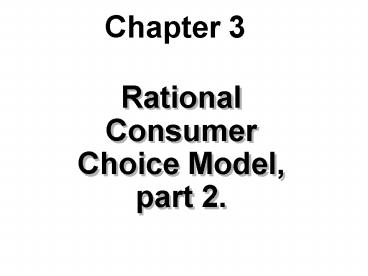Rational Consumer Choice Model, part 2. PowerPoint PPT Presentation
1 / 18
Title: Rational Consumer Choice Model, part 2.
1
Chapter 3
- Rational Consumer Choice Model, part 2.
2
Consumer Preferences
- Consumer is rational. That is consumer
preferences satisfy the following - 1) Preferences are complete.
- 2) Preferences are transitive.
- 3) Non-Satiation Consumers always prefer more
of any good to less.
3
Consumer Preferences
Market Basket Units of Food Units of Clothing
- A 20 30
- B 10 50
- D 40 20
- E 30 40
- G 10 20
- H 10 40
4
Consumer Preferences
Clothing (units per week)
50
40
30
20
10
Food (units per week)
10
20
30
40
5
Indifference Curve
Clothing (units per week)
50
40
30
20
10
Food (units per week)
10
20
30
40
6
Indifference Map
Clothing (units per week)
Food (units per week)
7
Indifference curves
- Indifference curves represent all combinations of
market baskets that provide the same level of
satisfaction to a person. - Any market basket lying above and to the right of
an indifference curve is preferred to any market
basket that lies on the indifference curve. - An indifference map is a set of indifference
curves that describes a persons preferences for
all combinations of two commodities. - Each indifference curve in the map shows the
market baskets among which the person is
indifferent.
8
Characteristics of Indifference Curves
- Indifference curves are negatively sloped.
- Positively sloped ICs would violate the
non-satiation assumption (more of any commodity
is preferred to less.) - Indifference curves cannot intersect.
- This would violate the assumption that more is
preferred to less (see next slide for graph). - Indifference curves are convex to the origin
- Law of diminishing marginal rate of substitution
(MRS).
9
Characteristics of Indifference Curves
2). Indifference Curves Cannot Cross
Clothing (units per week)
Food (units per week)
10
Characteristics of Indifference Curves
- 3. Convex Slope of Indifference Curves
- The slope of the indifference curve measures the
amount of one good a consumer will give up to
obtain more of another good. - The amount of one good a consumer will give up to
obtain more of another good is called the
marginal rate of substitution (MRS) . - Convex slope implies that, along an indifference
curve there is a diminishing marginal rate of
substitution.
11
Marginal Rate of Substitution
Clothing (units per week)
16
14
12
10
Question Does this relation hold for giving up
food to get clothing?
8
6
4
2
Food (units per week)
2
3
4
5
1
12
Diminishing Marginal Rate of Substitution
A
Clothing (units per week)
16
14
MRS 6
-6
12
10
B
1
8
-4
D
MRS 2
6
1
E
-2
G
4
1
-1
1
2
Food (units per week)
2
3
4
5
1
13
Diminishing Marginal Rate of Substitution
- Indifference curves are convex because as more of
one good is consumed, a consumer would prefer to
give up fewer units of a second good to get
additional units of the first one. - Law of diminishing marginal utility.
14
Marginal Rate of Substitution
Apple Juice (glasses)
Two goods are perfect substitutes when the
marginal rate of substitution of one good for the
other is constant.
4
3
2
1
Orange Juice (glasses)
2
3
4
1
0
15
Marginal Rate of Substitution
Left Shoes
4
3
Two goods are perfect complements when the
indifference curves for the goods are shaped as
right angles.
2
1
2
3
4
1
0
Right Shoes
16
People With Different Tastes The Case of Judy
and Punch
Judys Preference High MRS
Styling of cars
Performance of cars
17
People With Different Tastes The Case of Judy
and Punch
Styling of cars
Punchs Preference Low MRS
Performance of cars
18
Unusual Consumer Preferences
- BADS
- Things for which less is preferred to more
- Examples
- Air pollution
- Asbestos
- Do It Yourself
- How can we account for Bads in the analysis of
consumer preferences? What would the ICs look
like?

